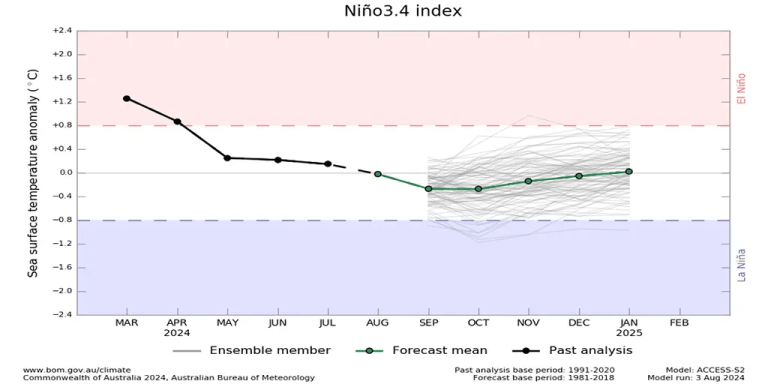Weather from Gujarat
Ashok Patel
NOAA standards suggest a full-blown La Niña is unlikely in 2024 — even a single La Niña is unlikely during India's southwest monsoon
Enso status August 8, 2024
Analysis and commentary by Ashok Patel:
ONI data has been obtained from CPC – NWS – NOAA and is available here
Current data indicate that the second ENSO neutral threshold has been established in late July 2024, so Enso neutral conditions persist. The ONI for the MJJ 2024 season has dropped to +0.2°C. The Nino3.4 SST in June 2024 is 0.18°C and in July 2024 is 0.10°C, so for the ONI of JJA2024, the total Nino3.4 SST for the three months of June, July and August 2024 should be Down to at least -1.36°C, giving an ONI of -0.5°C for JJA2024, rounded to one decimal place.
Since the Nino3.4 sea temperature in June is 0.18°C and July is 0.10°C, this means that the Nino3.4 sea temperature in August should theoretically drop to -1.64°C, so the total temperature for the three months is -1.36°C enables JJA2024 ONI -0.5°C to achieve La Niña threshold maintenance. Observing the weekly Nino3.4 data, it is extremely unlikely that the Nino3.4 SST in August 2024 will drop to -1.64°C. Therefore, the ENSO-neutral condition is expected to continue in the JJA2024 season.
From the above analysis, it can be seen that JJA will be in Enso neutral conditions in 2024 and the end of August, because there are only four months left in this year, and even if La Niña reaches the threshold in 2024, the La Niña phenomenon in 2024 will not be established. One month.
The first conclusion is that a La Niña threshold will not occur during the southwest monsoon in India; the second conclusion is that a full-scale La Niña phenomenon will not occur in 2024 according to NOAA standards.
The second conclusion of the discussion is that since the La Niña threshold for JJA 2024 cannot be achieved, the earliest La Niña threshold that can be achieved is JAS2024, which is the end of the Indian summer monsoon.
How ONI determines:
ONI is based on the deviation of SST in the Niño 3.4 region from the average and is the main measure for monitoring, evaluating and predicting ENSO. Defined as the three-month continuous average sea temperature departure from the El Niño 3.4 region. Departures are based on a further improved analysis of a homogeneous set of historical sea surface temperatures (Extended Reconstructed Sea Surface Temperatures – ERSST.v5).
NOAA's operational definition of El Niño and La Niña, El Niño: Characterized by positive ONI greater than or equal to +0.5°C. La Niña phenomenon: It is characterized by negative ONI less than or equal to -0.5℃. By historical standards, to be classified as a mature El Niño or La Niña event, these thresholds must be exceeded during at least 5 consecutive overlapping 3-month seasons.
The CPC considers El Niño or La Niña conditions to have occurred when monthly Niño3.4 OISST deviations reach or exceed +/- 0.5°C and atmospheric characteristics are consistent. It must also be predicted that these anomalies will persist for 3 consecutive months.
this Climate Prediction Center (Communist Party of China) is a U.S. federal agency, one of NECP and part of NOAA
Latest Oceanic Nino Index Map Shows Enso Neutral
Conditions effective end of July 2024

The table below shows monthly sea surface temperatures in the Nino3.4 region as well as climate-adjusted normal sea surface temperatures and sea surface temperature anomalies since February 2023. ERSST.v5
Period Nino3.4 ClimAdjust YR MON Temp.ºC Temp.ºC ANOM ºC 2023 2 26.30 26.76 -0.46 2023 3 27.19 27.29 -0.11 2023 4 27.96 27.83 0.14 2023 5 28.40 27.94 0.46 2023 6 28.57 27.73 0.84 2023 7 28.31 27.29 1.02 2023 8 28.21 26.86 1.35 2023 9 28.32 26.72 1.60 2023 10 28.44 26.72 1.72 2023 11 28.72 26.70 2.02 2023 12 28.63 26.60 2.02 2024 1 28.37 26.55 1.82 2024 2 28.28 26.76 1.52 2024 3 28.42 27.29 1.12 2024 4 28.60 27.83 0.78 2024 5 28.17 27.94 0.24 2024 6 27.91 27.73 0.18 2024 7 27.39 27.29 0.10
Instructions and analyzes from various international weather/climate agencies monitoring conditions in Enso are as follows:
Abstract: Climate Prediction Center/NCEP, August 8, 2024
ENSO Alert System Status: La Niña Watch
Summary: ENSO neutrality is expected to persist in the coming months, with La Niña most likely to occur between September and November (66% chance) and persist into the 2024-25 Northern Hemisphere winter (November to January 74% chance).
Note: Statements related to the ENSO diagnostic discussion are updated monthly (on the second Thursday of each month) and can be found by clicking here.
According to the latest (preliminary) Southern Oscillation Index from The Long Paddock, Queensland Government.

According to data from the Queensland Government The Long Paddock, the 30-day average SOI as of the end of July 2024 was -5.83, as of August 6, 2024 it was -8.85, and as of August 6, 2024, the 90-day average SOI was -3.06.
According to BOM – Australia August 6, 2024
ENSO neutral; potential for spring La Niña development (Southern Hemisphere)
The ENSO Outlook is currently on a La Niña watch, meaning there are some signs that a La Niña condition may develop in the Pacific later in 2024. La Niña observations are based on climate model projections and current atmospheric and oceanic conditions in the Pacific. Atmospheric and oceanic indicators are currently within the ENSO neutral threshold. Although ENSO is likely to remain neutral until at least early spring. Starting in October, 3 out of 7 climate models indicate
SSTs are likely to cool to La Niña thresholds (below -0.8°C). The remaining models indicate that ENSO-neutral conditions will persist throughout the forecast period.
Note: All seasons mentioned in the BOM are for the Southern Hemisphere.

Relevant
